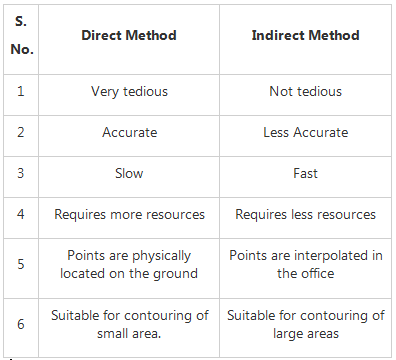Civil Engineering (CE) Exam > Civil Engineering (CE) Questions > The indirect method of contouring has all the...
Start Learning for Free
The indirect method of contouring has all the following advantages over direct method except:
- a)Economy
- b)Suitability
- c)Accuracy
- d)Suitability for large projects
Correct answer is option 'C'. Can you explain this answer?
Verified Answer
The indirect method of contouring has all the following advantages ove...
Direct Method v/s Indirect Method of contouring:

Most Upvoted Answer
The indirect method of contouring has all the following advantages ove...
**Explanation:**
The indirect method of contouring is a technique used in surveying to determine the shape of the land surface, particularly in areas with uneven terrain. It involves the use of contour lines, which connect points of equal elevation, to create a contour map.
The indirect method of contouring has several advantages over the direct method, which involves physically measuring the elevation at each point on the ground. These advantages include:
**1. Economy:**
- The indirect method is generally more economical than the direct method because it requires fewer field measurements.
- It relies on the interpolation of elevation values between known points, reducing the need for extensive field work.
**2. Suitability:**
- The indirect method is suitable for areas with complex terrain or limited access.
- It can be used in situations where it is difficult or impractical to measure the elevation at every point on the ground.
**3. Suitability for large projects:**
- The indirect method is particularly well-suited for large projects that cover a wide area.
- It allows for the efficient collection of elevation data over a large extent of land.
However, the indirect method of contouring does have one disadvantage compared to the direct method:
**4. Accuracy:**
- The indirect method may not be as accurate as the direct method because it relies on interpolation and estimation.
- It assumes that the elevation values between known points vary smoothly and continuously, which may not always be the case.
- In areas with abrupt changes in elevation or irregular topography, the indirect method may produce less accurate results.
Therefore, the correct answer is option 'C' - Accuracy. The indirect method of contouring does not have an advantage in terms of accuracy compared to the direct method.
The indirect method of contouring is a technique used in surveying to determine the shape of the land surface, particularly in areas with uneven terrain. It involves the use of contour lines, which connect points of equal elevation, to create a contour map.
The indirect method of contouring has several advantages over the direct method, which involves physically measuring the elevation at each point on the ground. These advantages include:
**1. Economy:**
- The indirect method is generally more economical than the direct method because it requires fewer field measurements.
- It relies on the interpolation of elevation values between known points, reducing the need for extensive field work.
**2. Suitability:**
- The indirect method is suitable for areas with complex terrain or limited access.
- It can be used in situations where it is difficult or impractical to measure the elevation at every point on the ground.
**3. Suitability for large projects:**
- The indirect method is particularly well-suited for large projects that cover a wide area.
- It allows for the efficient collection of elevation data over a large extent of land.
However, the indirect method of contouring does have one disadvantage compared to the direct method:
**4. Accuracy:**
- The indirect method may not be as accurate as the direct method because it relies on interpolation and estimation.
- It assumes that the elevation values between known points vary smoothly and continuously, which may not always be the case.
- In areas with abrupt changes in elevation or irregular topography, the indirect method may produce less accurate results.
Therefore, the correct answer is option 'C' - Accuracy. The indirect method of contouring does not have an advantage in terms of accuracy compared to the direct method.
Free Test
FREE
| Start Free Test |
Community Answer
The indirect method of contouring has all the following advantages ove...
C

|
Explore Courses for Civil Engineering (CE) exam
|

|
Question Description
The indirect method of contouring has all the following advantages over direct method except:a)Economyb)Suitabilityc)Accuracyd)Suitability for large projectsCorrect answer is option 'C'. Can you explain this answer? for Civil Engineering (CE) 2025 is part of Civil Engineering (CE) preparation. The Question and answers have been prepared according to the Civil Engineering (CE) exam syllabus. Information about The indirect method of contouring has all the following advantages over direct method except:a)Economyb)Suitabilityc)Accuracyd)Suitability for large projectsCorrect answer is option 'C'. Can you explain this answer? covers all topics & solutions for Civil Engineering (CE) 2025 Exam. Find important definitions, questions, meanings, examples, exercises and tests below for The indirect method of contouring has all the following advantages over direct method except:a)Economyb)Suitabilityc)Accuracyd)Suitability for large projectsCorrect answer is option 'C'. Can you explain this answer?.
The indirect method of contouring has all the following advantages over direct method except:a)Economyb)Suitabilityc)Accuracyd)Suitability for large projectsCorrect answer is option 'C'. Can you explain this answer? for Civil Engineering (CE) 2025 is part of Civil Engineering (CE) preparation. The Question and answers have been prepared according to the Civil Engineering (CE) exam syllabus. Information about The indirect method of contouring has all the following advantages over direct method except:a)Economyb)Suitabilityc)Accuracyd)Suitability for large projectsCorrect answer is option 'C'. Can you explain this answer? covers all topics & solutions for Civil Engineering (CE) 2025 Exam. Find important definitions, questions, meanings, examples, exercises and tests below for The indirect method of contouring has all the following advantages over direct method except:a)Economyb)Suitabilityc)Accuracyd)Suitability for large projectsCorrect answer is option 'C'. Can you explain this answer?.
Solutions for The indirect method of contouring has all the following advantages over direct method except:a)Economyb)Suitabilityc)Accuracyd)Suitability for large projectsCorrect answer is option 'C'. Can you explain this answer? in English & in Hindi are available as part of our courses for Civil Engineering (CE).
Download more important topics, notes, lectures and mock test series for Civil Engineering (CE) Exam by signing up for free.
Here you can find the meaning of The indirect method of contouring has all the following advantages over direct method except:a)Economyb)Suitabilityc)Accuracyd)Suitability for large projectsCorrect answer is option 'C'. Can you explain this answer? defined & explained in the simplest way possible. Besides giving the explanation of
The indirect method of contouring has all the following advantages over direct method except:a)Economyb)Suitabilityc)Accuracyd)Suitability for large projectsCorrect answer is option 'C'. Can you explain this answer?, a detailed solution for The indirect method of contouring has all the following advantages over direct method except:a)Economyb)Suitabilityc)Accuracyd)Suitability for large projectsCorrect answer is option 'C'. Can you explain this answer? has been provided alongside types of The indirect method of contouring has all the following advantages over direct method except:a)Economyb)Suitabilityc)Accuracyd)Suitability for large projectsCorrect answer is option 'C'. Can you explain this answer? theory, EduRev gives you an
ample number of questions to practice The indirect method of contouring has all the following advantages over direct method except:a)Economyb)Suitabilityc)Accuracyd)Suitability for large projectsCorrect answer is option 'C'. Can you explain this answer? tests, examples and also practice Civil Engineering (CE) tests.

|
Explore Courses for Civil Engineering (CE) exam
|

|
Signup for Free!
Signup to see your scores go up within 7 days! Learn & Practice with 1000+ FREE Notes, Videos & Tests.


















